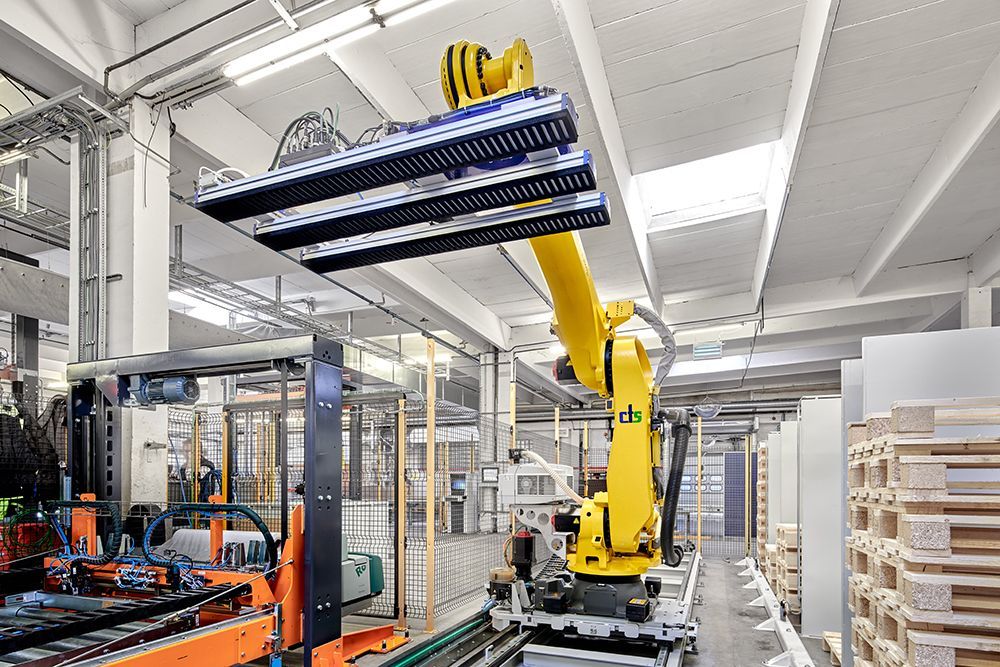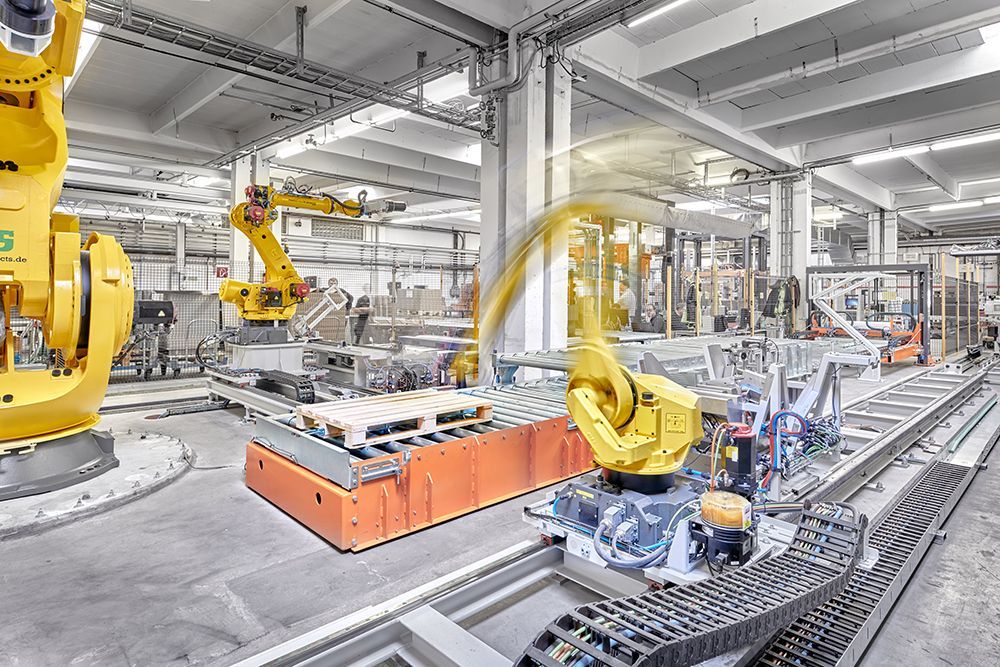Foil roll game for robots
Article in the special issue AUTOMATION
Robot ballet gives packaging system Industry 4.0 flexibility
Für den Folienhersteller Klöckner Pentaplast schuf das Automatisierungsunternehmen cts GmbH eine hochflexible, vollautomatische Verpackungs- und Palettieranlage für täglich bis zu 3.000 aufgerollte Folien mit Stückgewichten von 10kg- bis 1,5 t-Rollen. Ihre enorme Flexibilität verdankt die 30 x 40 m große Anlage dem Zusammenspiel von fünf Fanuc-Industrierobotern. Leichtes Spiel mit schweren Rollen hat dabei der mit 2,3 t Tragkraft weltgrößte 6-Achs-Knickarmroboter Fanuc M-2000iA/2300.
Der Einsatz von Kunststofffolien als Vorprodukt zieht sich über alle Lebensbereiche und reicht von der Verpackung für Lebensmittel oder Elektronik bis zu Klebebändern, Bodenbelägen und Kreditkarten. Aber auch für sich allein treffen Konsumenten die vielseitigen Kunststofffolien überall an, sei es in bedruckter Form für PET-Flaschen, als Weinkapselfolie oder Paketklebebänder.
Globally active film manufacturer
Klöckner Pentaplast is one of the world's leading suppliers of rigid and flexible plastic films for pharmaceutical, medical device, food, electronics and consumer goods packaging as well as for printing and specialty applications. With a broad and innovative portfolio of packaging and product films and services, Klöckner plays an important role in its customers' value chain by ensuring product integrity, protecting brand reputation and improving sustainability. Founded in 1965, the company has 31 plants in 18 countries and employs more than 5,900 people working for customers at over 60 locations globally.
The Gendorf plant in Burgkirchen an der Alz (Germany) near the Austrian border is one of Klöckner Pentaplast's 31 plants worldwide. The company produces a wide range of plastic films there. “After extrusion or calendering, the films are wound onto large parent rolls, processed in various ways, cut and initially stored temporarily,” explains Thomas Friedlsperger, Project Engineer & Energy Manager Pharma, Health & Protection and Durables at Klöckner Pentaplast GmbH. “They are then transported to the crane system using an automated guided vehicle and then fully automatically to the packaging and palletizing system.”
The challenge of film packaging
Around 50,000 tons of film leave the factory every year. These have very different thicknesses depending on their purpose. The dimensions of the 1,000 or so rolls produced every day are just as varied. They range from 100 to 1,550 mm wide with diameters of up to 800 mm and unit weights of 10 kg to 1.5 tons. The films, which are wound onto cores with two different diameters, have to be packaged using 30 different packaging materials - e.g. end protectors - and then palletized.
As the rolls are produced continuously, they are packaged around the clock in three-shift operation. In the past, a rail system with pneumatically and hydraulically operated pushers was used for transportation within the packaging hall. The actual packaging process was carried out manually. “Handling the rolls in particular was very physically demanding,” recalls Thomas Friedlsperger. “As most of the rolls weighed over 20 kg, this work was not ergonomic.”
Packaging automation wanted
It was therefore obvious to automate the packaging and palletizing of the film rolls in order to relieve the employees previously employed here of this heavy work and free them up for other tasks. However, Klöckner Pentaplast did not want to do things by halves. In order to be able to retrieve the rolls as required, the system had to be able to pack and palletize the rolls in any sequence - down to batch size 1 - largely without human intervention. After the initial search for bidders, two suppliers from the region were shortlisted. In order to obtain a solid decision-making basis for the investment, the film manufacturer commissioned both to draw up an automation concept.
Robotics brings flexibility
The contract for the implementation was awarded to cts GmbH. Founded in 2006, the owner-managed company has a holistic approach to the task of system automation and extensive experience in working with industrial robots. “The different positioning of rolls, tapes and labels with a total of 1,500 possible combinations to create packages ready for dispatch with around 200 packing patterns requires enormous flexibility,” explains Fabian Wieser, who heads the production automation project department at cts. “This is why there are five industrial robots at the heart of the 30 x 40 m system with lots of conveyor technology and special machines.”
For one of them, the world's largest 6-axis articulated arm robot M-2000iA/2300 from Fanuc with a load capacity of 2.3 tons and a reach of 3,734 mm, this was one of the first deployments in Europe. “The giant was the key to success for our project,” confirms Fabian Wieser. “It enabled us to offer a fully robot-based and therefore much more flexible system for packaging all rolls, even the heaviest ones.”
Yellow robotic ballet
Zwei der fünf Fanuc-Roboter sind mit dem Boden verbunden und stehen direkt nebeneinander. Sie nehmen die herannahenden Rollen auf und stellen oder legen sie auf eine Palette. Ab einem bestimmten Rollengewicht übernimmt diese Aufgabe der bereits erwähnte M-2000iA/2300. Leichtere Rollen handhabt der deutlich schnellere R-2000iC/165F mit 165 kg maximaler Last am Handgelenk und 2.655 mm Reichweite. Beide sind mit Spezialgreifern ausgestattet, die das Aufnehmen aller möglichen Rollen ohne Greiferwechsel ermöglichen, unabhängig von deren unterschiedlichen Kerndurchmessern.Neuer
Das Kommissionieren der Rollenpakete, also etwa das Zusammensetzen und Aufstecken von Stirnschutzscheiben, ist die Aufgabe eines M-710iC/45M. Der Roboter hat ein erhöhtes Trägheitsmoment und bewegt bis zu 45 kg über 2.606 mm Reichweite. Die Vorratsbehälter mit den Packstoffen fährt er auf einer mehr als 6,5 m langen Linearachse ab. Die Paletten, auf denen er die Pakete zusammenstellt, bringt ein R-2000iC/210L. Seine Langarmausführung ermöglicht Reichweiten bis zu 3.100 mm, die 210 kg Traglast braucht er wegen des Sauggreifers, mit dem er die Ladungsträger aufnimmt. Um die sechs Palettenstapel zu erreichen, bewegt sich auch dieser Roboter auf einer Linearachse.
Nachdem die zusammengestellten Paletten in einer Verpackungsstation automatisch umwickelt werden, versieht ein weiterer Fanuc-Roboter die fertigen Pakete noch auf allen Seiten mit Etiketten. Der agile M-20iA/12L mit 2.009 mm Reichweite und innenliegender Kabelführung entnimmt diese direkt dem Drucker, der sie beim Eintreffen jedes Paketes frisch ausgibt.



Variety with series quality
cts chose Fanuc not only because of the world's largest robot, which was named “Bumblebee” at Klöckner Pentaplast. The Upper Bavarian automation company has a long-standing collaboration in many areas with the Japanese manufacturer of CNC controls, processing and plastics processing machines and industrial robots.
This already proved to be extremely helpful during the project creation phase. The system was malfunctioning, the cause of which was difficult to determine. “When it turned out that a subcontractor had incorrectly designed a 7th axis, Fanuc took over the redesign immediately and free of charge,” says Fabian Wieser, who is highly satisfied with the excellent support provided by Fanuc Austria. He is convinced that this will also ensure that the film manufacturer can look forward to many years of operation of the system with high availability.
Reliability thanks to Genmitsu
“The premium manufacturer from Japan also has by far the largest range of industrial robots,” says Fabian Wieser. “There is always a suitable model variant, even for unusual requirements, without the need for special production or customization.” This also contributes to the high quality and durability of Fanuc robots. “Just like the controllers and CNC machines, Fanuc produces the robots with a high level of vertical integration and the highest degree of automation exclusively at the FANUC City site in Oshino-mura at the foot of Mt. Fuji,” explains Bernhard Blöchl, Manager Sales RO / RD Austria at Fanuc Österreich GmbH. “They are produced according to the Genmitsu principle, which is synonymous with precision, uncompromising quality and perfectionism.” “The cts system not only offers enormous flexibility and the ability to wrap film rolls of up to 1.5 tons,” confirms Thomas Friedlsperger. “Not least thanks to the high reliability of the Fanuc robots, it does this with maximum precision around the clock.”
Article: xtechnik AUTOMATION
Unternehmen | About cts
Kontakt | Contact
Karriere | Career
Impressum | Imprint
Datenschutz | Privacy
AGB | GTC
Blog | News
Presse | Press
Glossar | Glossary

cts GmbH competence for technical solutions
Fuhrmannstraße 10
84508 Burgkirchen a.d. Alz
All rights reserved cts GmbH 2025 ©


